Mobile Push Notifications
Once you have configured at least one of APNS or FCM, you can send mobile push notifications from your agency console. Your client can also send push notifications from their client portal if you have enabled this for them.
This guide shows you how to send push notifications to users of your native mobile apps. If you also have a website, then you can follow the same process to send notifications to users across your mobile apps AND website at the same time. Alternatively, you can use segments to limit the audience to your mobile app users only, for example.
To send a message from your console, click on the app and then select 'Messaging' from the left menu. Click the primary action button to display the Compose Message wizard that will walk you through five simple steps to sending a mobile push notification:
- Choose the Message Type
- Select the target Audience
- Design the message Content
- Pick one or more Delivery times
- Review & Send the message
Message Type¶
First, choose which type of message you want to send, select 'Push Notification' and click 'Next'.
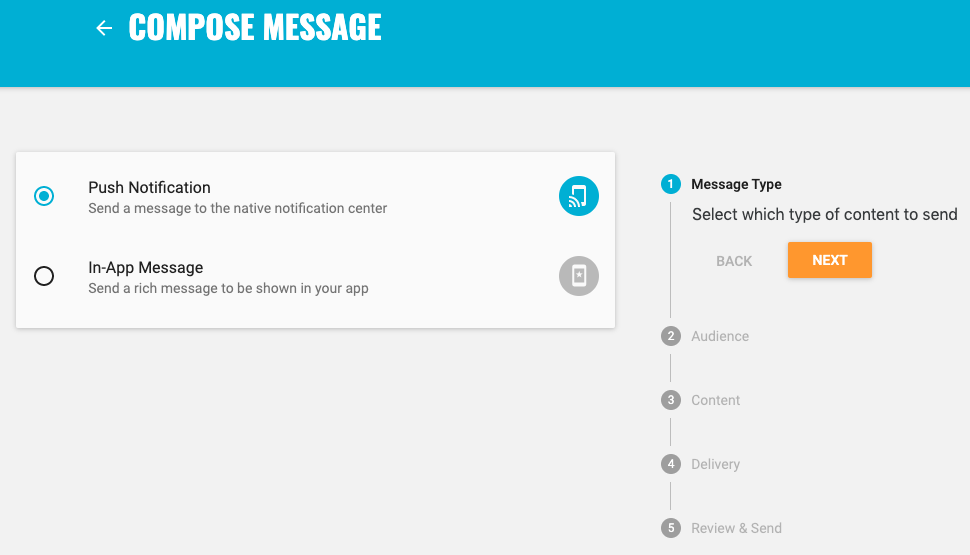
Audience¶
Next, choose the audience that you want to send the message to. You can send a broadcast to all users subscribed to receive push notifications or target a specific segment, channel and/or geofence.
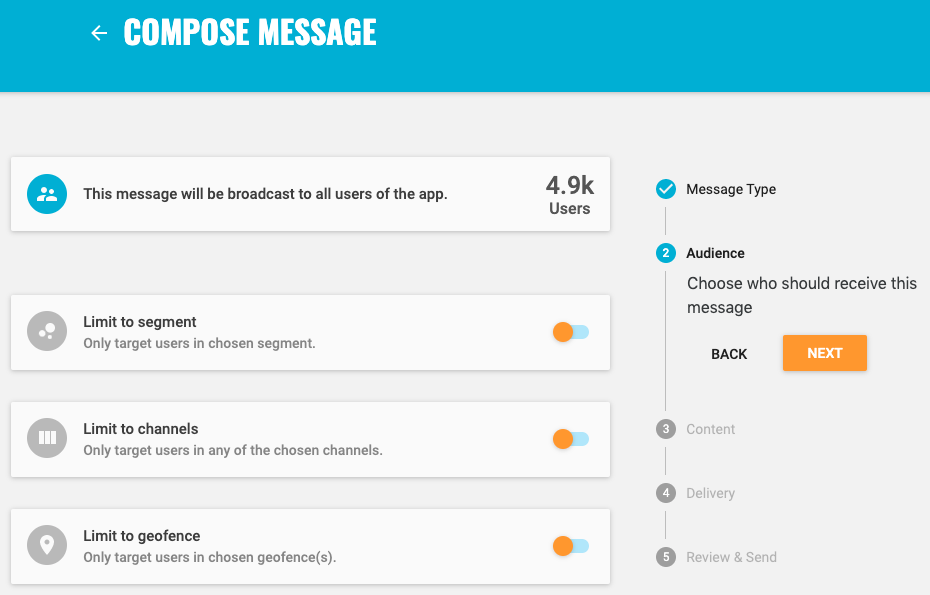
As you select a segment, a channel and/or geofence(s), the wizard will tell you how many users will be targeted and are reachable by (have subscribed to receive) push notifications.

To send the notification to an audience segment, toggle 'Limit to segment' and select the segment from the drop-down list.
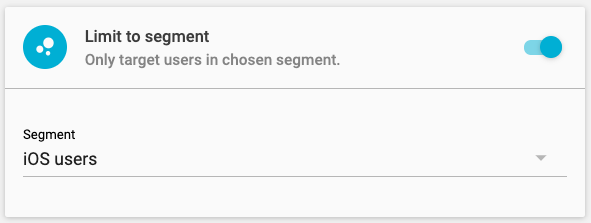
To send the notification to installs subscribed to a channel, toggle 'Limit to channel' and select the channel from the drop-down list.
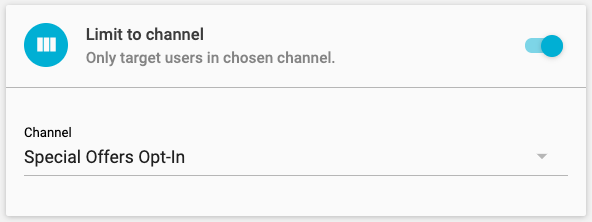
To send the notification to installs in a geofence, toggle 'Limit to geofence' and choose one of the following options, depending which geofence(s) you want to target.
- If you want to send the notification to installs in any geofence, select 'All enabled geofences'.
- If you want to send the notification to installs in one (or more) geofences, then select 'Specific geofences' and then add the geofence(s) from the drop-down list.
- If you want to send the notification to installs in geofences that match one or more tags, then select 'Geofences matching tags' and select the tags from the drop-down list.
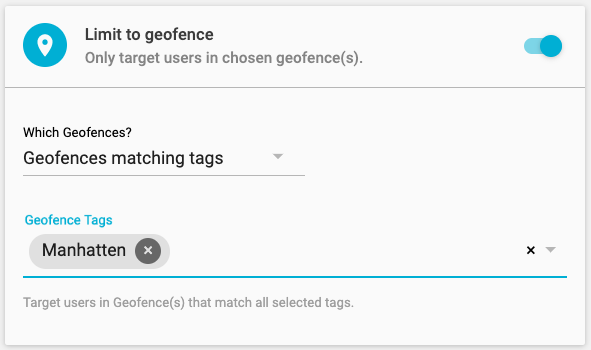
If you select an audience segment, a channel and a geofence, then an install must match all of the filters in the segment, be subscribed to the channel and be in the geofence at the time the notification is scheduled to be sent in order for the notification to be sent to that install.
Click 'Next' when done.
Content¶
Now, define the content of the notification. You can either select from a template or write the content from scratch. If you are creating a new message you will need to select whether you want the notification to appear in the foreground by adding a title and a message. Use the emoji pickers to add emojis to your title or include images in the opened notification as required.
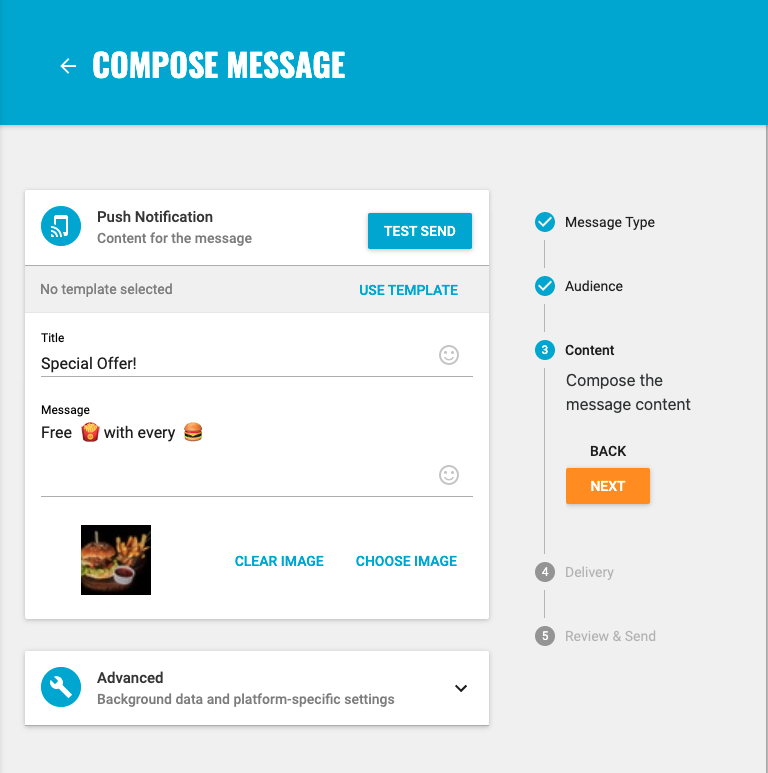
If your template contains any dynamic content tags, then enter appropriate values for each tag here.

Kumulos supports Emoji v4.0 / Unicode version 9.0 which is fully supported in iOS 10.3 and Android v7. Older versions of iOS and Android may not support all emojis available. See Emojipedia for more details of what emojis are supported in which versions.
As you add content to the notification you can preview how the notification will look on a user's device. By default, the preview shows how the notification will look when it arrives on an iPhone.

Click the Android tab to see how the notification will look when it arrives on an Android phone.
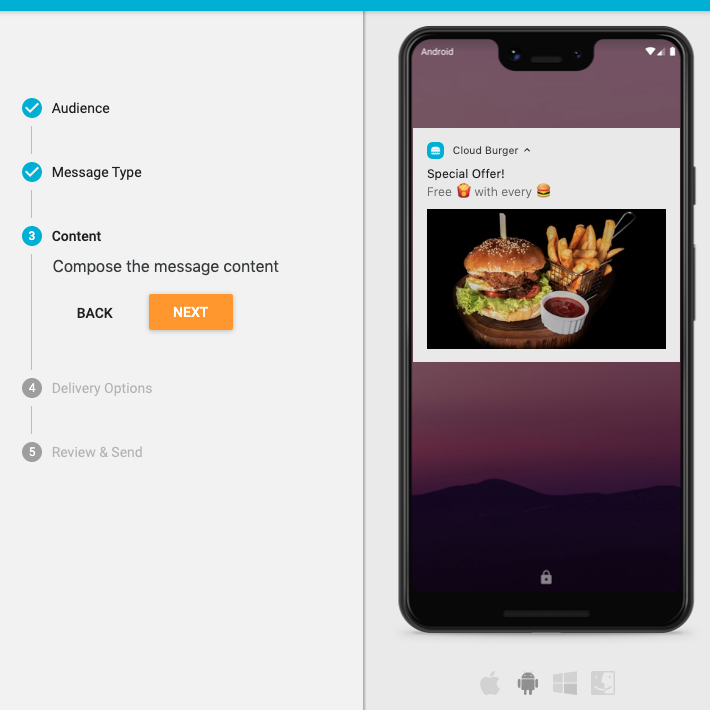
If you have added an image or buttons, click the notification to see how it will look when the user expands the notification on their phone.
If you have added yourself and your team to the Testers channel, you can use the 'Test Send' button to send the push notification or to everyone in the Testers channel, to see how the message will appear on your own device, before sending to your audience.
Personalization¶
In your text, you can also add user attributes to personalize the message. Enclose user attributes in double braces and include a default value {{user.attributeName|default('defaultValue')}}. The defaultValue will be used if the attribute attributeName is not set for a given user.
Image¶
If you want to add a picture to your notification, click 'Choose Image' to open your Media Library. Here, you can upload a new image, select an image you have previously uploaded or search the Unsplash stock image library.
To upload a new image, click the upload primary action button. Click 'Choose File' to browse your computer and find the image. Select any tags to help you find the image later or to add a new tag, just start typing and click 'Create new tag'. Click 'Upload' to add the image to your media library and include this in your push notification.
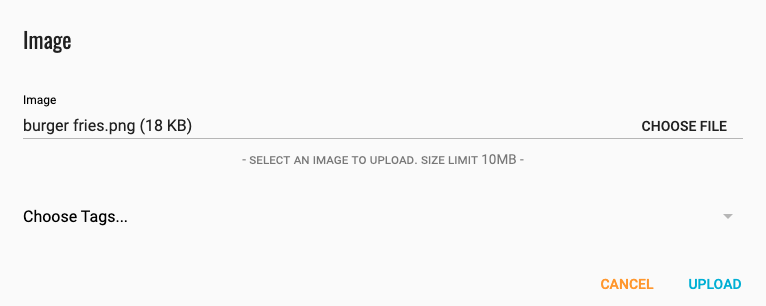
To use an image you have previously uploaded, simply select the image and click the tick primary action button. You can either scroll through your library or filter by the tags you have added previously.
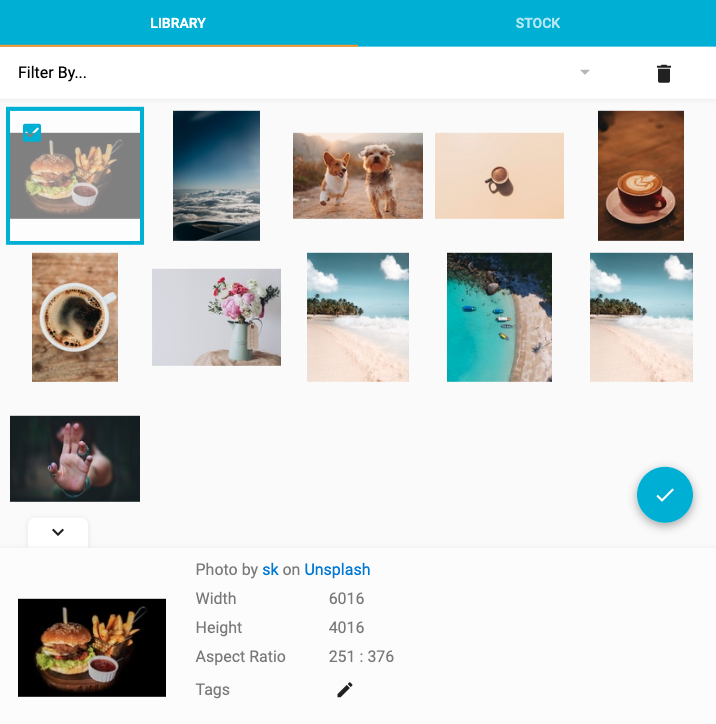
To use an image from the Unsplash stock image library, click the 'Stock' tab and enter one or more keywords in the search box. Scroll through the results and select an image to see more information about it. Once you have found the image, click the camera primary action button to add this image to your media library and include this in your push notification.

The preview will show how the notification will look when it arrives on a phone with a thumbnail image. Click the notification to see how it will look when the user expands the notification on their phone.
To remove the image from your push notification, click 'Clear Image'.
Advanced Options¶
To open a URL, add a data payload or set any platform specific options, expand 'Advanced'.
Open a URL¶
To open a URL when the push notification is tapped by the user, toggle the "Open URL" switch and enter the URL you want to open.
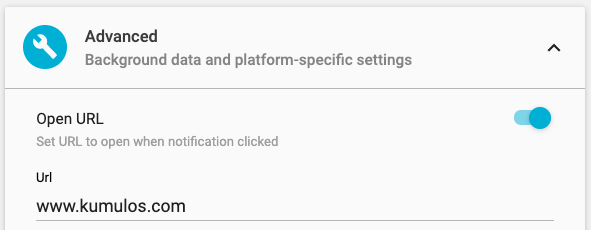
Ensure that you have reviewed the appropriate SDK integration guides to support URL push
Background¶
To send a notification that can be processed in the background, toggle the "Run background handler" switch. The title & message become optional, and can be omitted to create a silent push.
On iOS this will set the content-available flag on the notification.
Data¶
To add an arbitrary meta-data object to the push notification, for example to trigger a deep link, toggle the "Data" switch and enter a valid JSON object into the editor. Additional data can be consumed by the SDK, please refer to the platform integration guides for further information.

Action Buttons¶
You can add upto three action buttons to a push notification by toggling the "Action Buttons" switch. Enter the identifier (used by your app to determine what action to take) and text for each button. Optionally, you can add icons to the buttons for iOS15+ devices. To remove a button, click the trashcan icon.

The preview will show how the notification will look when it arrives on a phone with a thumbnail image. Click the notification to see how it will look when the user expands the notification on their phone.
Gateway TTL¶
You can optionally specify the gateway time to live (TTL), this tells the gateways how long a notification should be held for delivery attempts in cases where the recipient's device is currently disconnected from the internet. If not set this defaults to 3 days and the maximum is 28 days.

iOS Badges¶
To set the badge on your app on iOS, toggle the "Set Badge" switch. By clicking on "Badge Type" you can choose whether to set the badge to the absolute number you enter in "Count" or to Increment the badge by the positive or negative number you enter in "Count".
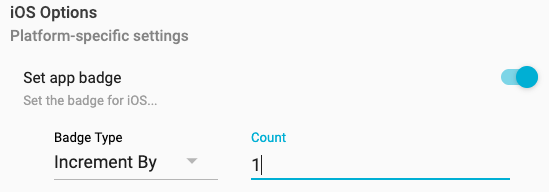
iOS Category¶
To set the category on your app on iOS, toggle the "Set Category" switch. Type in the category.

iOS (15+) Relevance Score¶
To set the relevance score for iOS, toggle the "Set Relevance Score" switch, and adjust the slider to the required score.

The relevance score is used to sort the notifications from your app. If more than one notification is available the highest relevance score will be presented in the notification summary.
iOS (15+) Interruption Level¶
To set the interruption level for iOS, toggle the "Set Interruption Level" switch, and select from the available options.
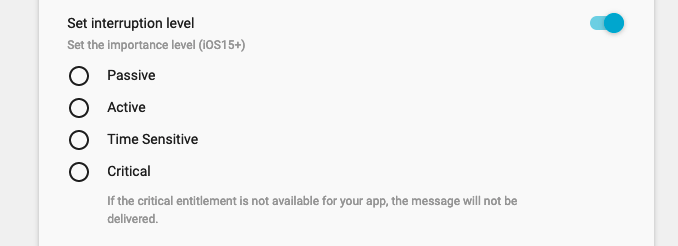
The available interruption levels are:
Active
The system presents the notification immediately, lights up the screen, and can play a sound.
Passive
The system adds the notification to the notification list without lighting up the screen or playing a sound.
Time-Sensitive
The system presents the notification immediately, lights up the screen, and can play a sound, but won’t break through system notification controls.
Critical
The system presents the notification immediately, lights up the screen, and bypasses the mute switch to play a sound.
If you select this option and your app does not have the neccessary entitlement then the message will not be delivered. The critical notification entitlement must be requested from Apple and is heavily restricted.
Android Priority for FCM¶
To set the priority flag and wake up Android devices, toggle the High Priority switch.
Android Notification Channel¶
You can choose how notifications should be presented on receipt by toggling on and selecting a notification channel.
-
General: The default Android push behavior, notifications are added to the tray
-
Important: Show a heads-up banner notification
-
Custom: Enter a notification channel ID created by your app
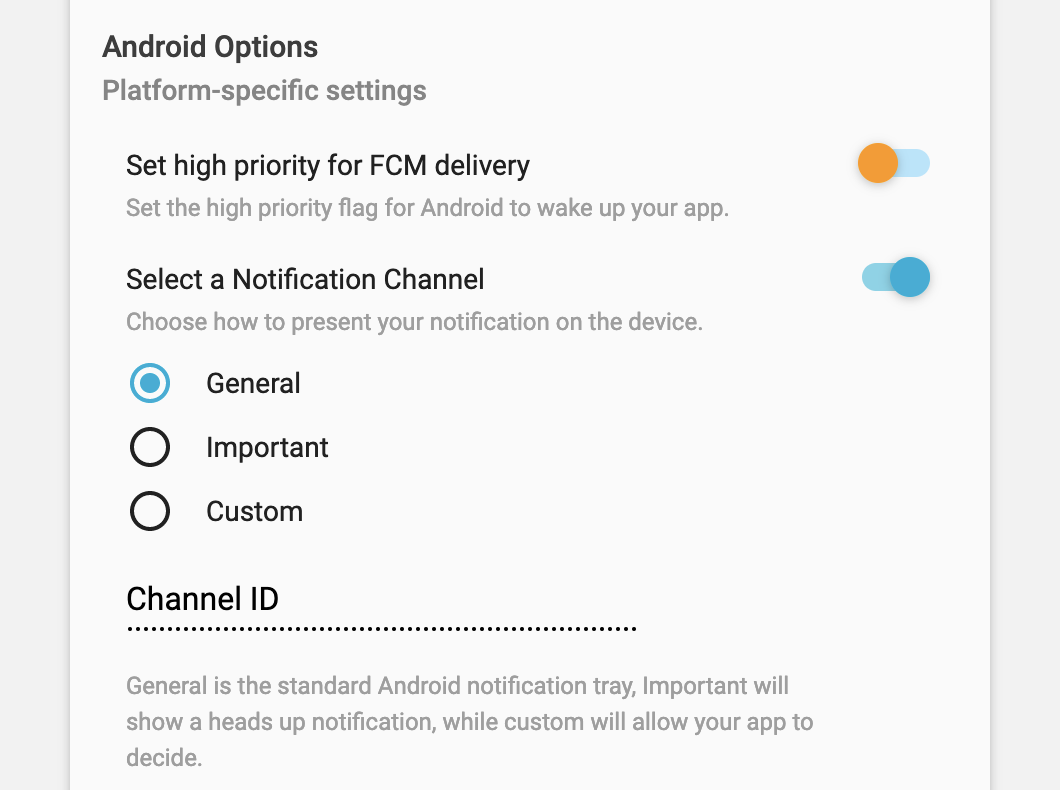
Delivery¶
Now decide when you want the message to be sent. You can:
- Send the message immediately, once now
- Schedule the message to be sent one or more times in the future
- Send the message repeatedly on a recurring schedule
- Deliver the message intelligently when each user is most receptive
- Throttle the delivery of the message, sending to the entire audience over a selected time window
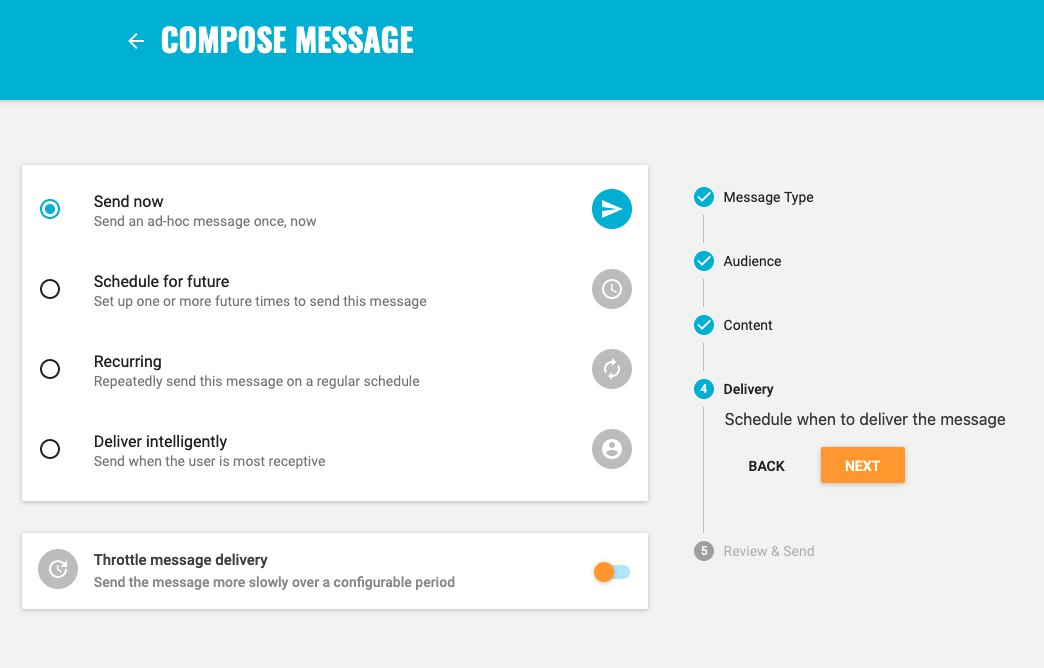
Send now¶
If you want the message to be sent immediately, just click "Next".
Schedule for future¶
If you want to schedule a message in advance to be sent one or more times in the future, select "Schedule for future".
Choose the date and time you want the notification to be sent and click "Add Time".
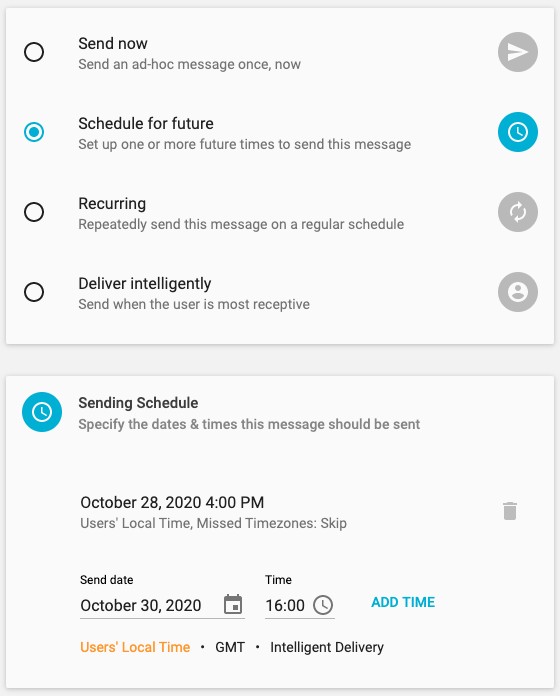
You can repeat this process to send the message again at other dates and times. To remove a date and time you have added, just click the trashcan icon. Click "Next" when done.
If you selected an audience segment, a channel and a geofence, then a user must match all the filters in the segment, be subscribed to the channel and be in the geofence at the time the message is scheduled to be sent in order for the message to be sent to that user.
Timezones¶
By default, the message will be sent at that date and time in the users' local timezone (according to the device on which the app is installed). If you want everyone to receive the message at exactly that same time, select your timezone before clicking "Add Time".
Alternatively, if you want to deliver the message when each user is most receptive, select "Intelligent Delivery" before clicking "Add Time". The message will then be delivered to each user at the time they most frequently use your app over the 24 hour period following the date and time you have specified.
If choosing to schedule the message to be sent in users' local timezone, what should Kumulos do for installs on devices for which this time has already passed? Should we "Skip" these installs or send at the same time, the "Next Day"?
For example: At 4pm on Christmas Eve, Marketing Mandy in New York decides to send a "Happy Christmas" notification to all of her customers at midnight on Christmas Day. However, for Surfer Steve in Sydney, that was already 6 hours ago. What should Kumulos do? In this example, Marketing Mandy should "Skip" Surfer Steve as a "Happy Christmas" notification on Boxing Day won't work.
Recurring¶
You can schedule the message to be sent on a repeating pattern by selecting "Recurring"
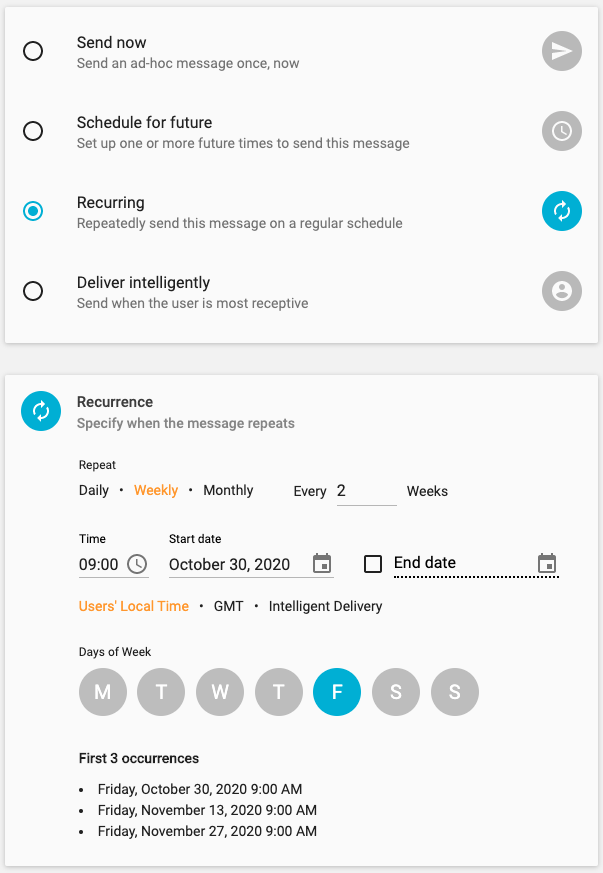
You can choose to repeat the message daily, weekly or monthly. For messages that repeat daily, specify on how many days the message should repeat.
For messages that repeat weekly, specify on how many weeks the message should repeat, and on which days of the week.
For messages that repeat monthly, specify on how many months the message should repeat, and on which days of the month (for example: the 26th day of the month, the fourth Friday of the month or the last Friday of the month etc).
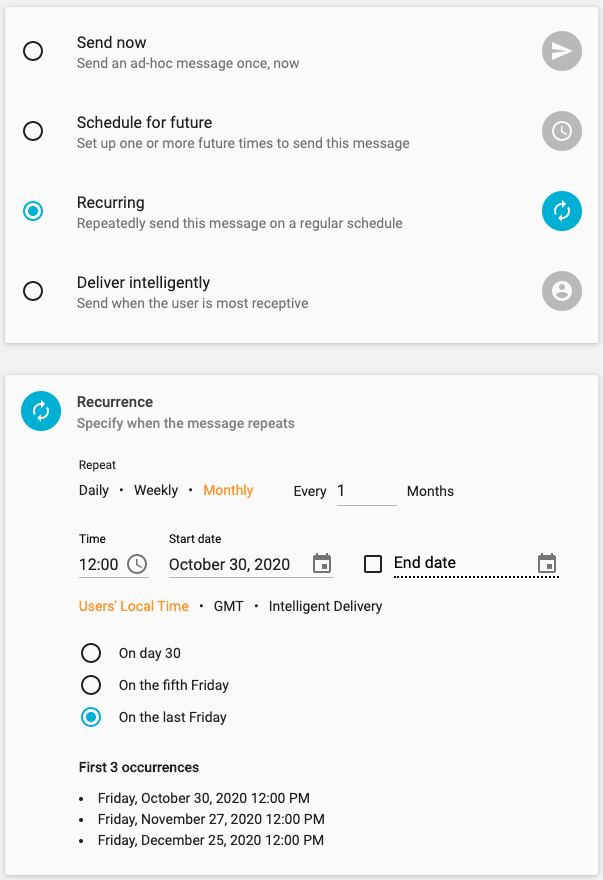
Enter the time the message should be sent (see note above about timezones), the start date when or after which first message should be sent and an optional end date after which no more messages will be sent. You can see the first three dates and times the message will be sent according to what you have entered above. Click "Next" when done.
We recommend you exercise caution and apply sensible audience targeting options when sending recurring messages to avoid over-communicating with your users, as this can lead to increased unsubscribes.
Intelligent Delivery¶
To deliver the message to each user when they will be most receptive, select "Deliver Intelligently".
Kumulos learns when each individual user uses your app (based on their sessions in the last 90 days) and gives you the option to deliver the message to each user when they will be most receptive, at the time they most frequently use your app. This maximizes the chance of each user interacting with the message to increase engagement.
If you select this option, Kumulos will deliver the message to each user over the next 24 hours.
Throttling¶
In order to ease pressure on back-end systems as a result of sending a notification you can select to release your message to the audience with throttling applied. If you select this option you can configure a period from 1 - 24 hours for the message to be delivered to your audience in batches, completing at the end of the selected delivery window.
Review & Send¶
Lastly, review the audience, content and delivery schedule you have set. Click 'Back' if you want to make any changes, or click 'Send' to send or schedule the push notification.

The notification will now appear under 'Recently created messages' in your Messaging Dashboard.
You can also create automation rules to automatically send notifications on a trigger such as a device entering or exiting a Geofence or coming into proximity of a Beacon. Alternatively, you can send push notifications from an other backend system using the Messaging API.